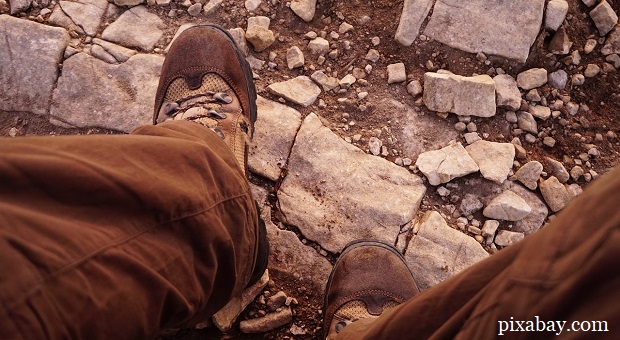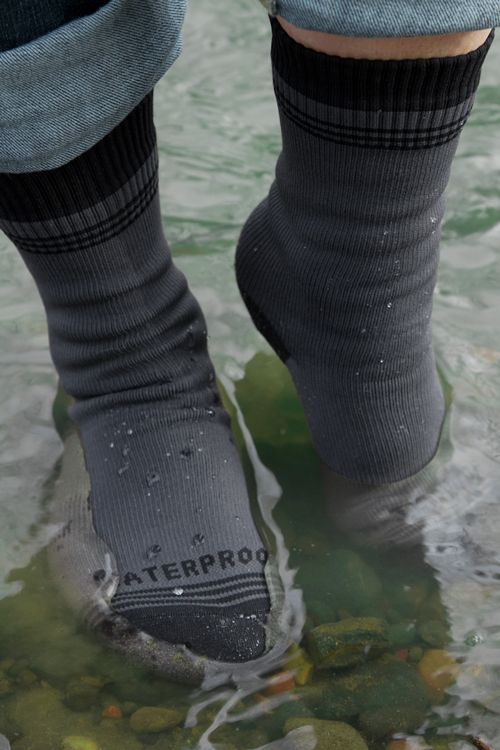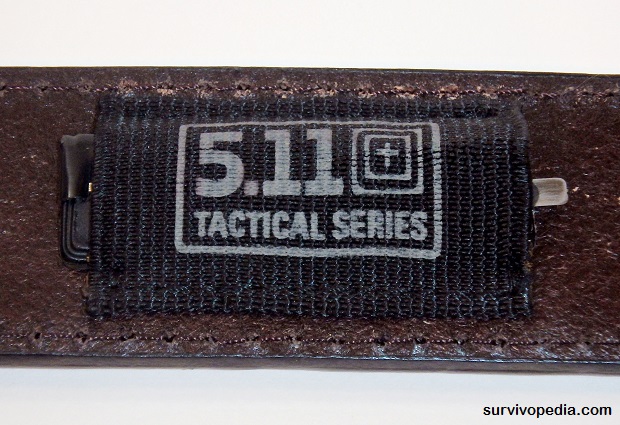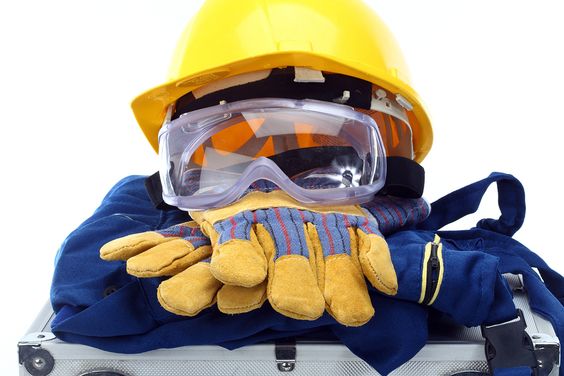Your clothing can make it difficult to come out on top from a life or death situation, and might even affect the lives of your loved ones.
Or leave you snug, warm and safe, against the harshest of elements… So, here’s one question you really have to answer: how much are your clothes helping or hindering you?
Keep reading to find out the rules of survival clothing and accessories!
Briefly:
- Turnout bags are not just for first responders, they work great for preppers too.
- Use an EDC Valet to organize your gear at the end of the day and keep it from wandering off.
- A core layer of Survival/Self-recovery gear should be worn and carried in your pockets instead of beingstored in your pack which gets doffed every time you climb into a vehicle, rest or take a swim. You pack is often separated from you when you need it most
- Every survivalist should carry bandanas, a neckerchief, a shemagh or some type of swatch of cotton fabric. It is one of the most useful and adaptable things you can carry. They are also inexpensive and low tech.
- If they have working legs, quality boots and socks should be one of the very first things survivalists should buy.
Modular, Layered Approach to Survival Clothing
This section classifies the core layers of clothing and equipment discussed in this article in the context of the Modular Survival Kit.
Turnout Bag & EDC Valet
In my role as a first responder, the turnout bag enabled me to dress fast without forgetting anything.
As a prepper, I had the same need, so I adapted the turnout bag for survival use and it works just as well with only minor modification. The principle modifications were to add and EDC Valet, checklists, modules and the creation of more than one turnout bag.
As preppers, environment, mission, roles and the threats we face determine the most effective clothing and equipment to survive. If I respond as a first responder, I need to wear my uniform and Personal Protective Equipment.
But If I respond to an emergency as a private citizen, depending on the threat and circumstances, I may want to blend in to a crowd or blend in to the environment using covert or overt camouflage.
Reversible clothing can help with this to a degree, but these environments generally dictate different clothing, so I have overt, covert and uniformed turnout bags.
How To Build a Small Bunker in Your Backyard with $400
Climatic conditions, mission, specific threats and environments can require the addition of special clothing and equipment. My solution to this was the creation of climate, environment and threat-specific modules and ensembles, so if I am going out into a blizzard, I add an extreme cold-weather ensemble.
If the threat is chemical, biological, radiological or nuclear, I add the CBRN ensemble. If I am going hunting or fishing, I may not need a specific turnout bag or ensemble for either of those activities, but having my gear together in one place does mean that it’s organized and that I will not forget anything.
Using the same system every single day means that I will go through the same motions on autopilot when I am getting ready under stress instead of freezing up. Since we fight the way we train, there is a certain logic behind using the same system day in and day out.
The role of the EDC valet is that once you dress, whether it is out of a turnout bag or out of a dresser. (These can be one and the same. Simply line drawers with removable turnout bags.)
EDC gear can be added independent of which turnout bag you dressed out of. At the end of the day, EDC gear goes back in the EDC Valet or tray, ready for the next day.
Since EDC varies greatly depending on whether you are going to work out or for a swim vs layer for a blizzard vs leave and possibly never come back, checklists ensure that nothing gets left behind and are especially helpful when dressing in a hurry under stress.
Clothing
In general terms, survival clothing should be clean and worn in loose-fitting layers. This way, layers can be added or removed as needed to adapt to ever-changing environmental conditions.
In the context of the Modular Survival Kit, clothing starts from the skin out and does not include PPE, footwear, accessories, EDC or other listed categories.
Personal Protective Equipment (PPE)
PPE is eye protection, hearing protection, antimicrobial, dust or gas masks, Tyvek® suits, elbow and knee pads, gloves, headwear and footwear designed to prevent injury, infection or exposure to hazardous materials.
Accessories
The accessory layer includes headwear, footwear, jewelry, watches, handkerchiefs, bandanas, headwear, belts and other clothing accessories.
Restraint Escape (RE)& Covert Survival/Self-recovery (SSR) Core Layer
This layer includes equipment and tools to facilitate escape from illegal or enemy restraint, escape, survival and self-recovery that is hidden on the person or disguised to avoid detection and confiscation.
Every Day Carry (EDC) & Survival/Self-recovery (SSR) Core Layer
This is the same category as the category above, only the equipment is not deliberately hidden or disguised to avoid detection and confiscation because of practical limits of what can be effectively concealed.
A core layer of SSR should be carried in your pockets instead of your pack which gets taken off every time you rest, climb into a vehicle and is easily separated from you when you needed most.
Survival Clothing
Features, materials and attributes that make clothing well-suited for survival use can vary widely. Clothing is best chosen based on your roles and pattern of life and the environments, climates and threats that you face.
General Survival – specific Features
There are too many features, materials and attributes that might be listed, but let’s list a few to provide guidance and get you thinking:
- Abrasion-resistant
- Antimicrobial–Cuts down on stinky clothing.
- CCW-specific Features– Concealed carry-specific clothing solves many of the problems that come with carrying concealed and is much safer than carrying in bags that get set down or stolen.
- Cotton– Cotton clothing could get you killed in winter or save you in the summer even in the same state, so “Never wear cotton.” Is bunk advice. Wear cotton when appropriate.
- Covert Tactical and Concealed Carry Features– Concealed carry-friendly clothing is a priority for me, but survival clothing does not have to scream, “Tactical!” If your clothing is recognizable as overtly tactical, you might as well wear a t-shirt that reads, “Shoot me first!”, especially if you are a military-age male.
- Creepy Crawly-related Features – Cuffs, Insect Repellant, Insect Netting, Snake-resistant boots
- Drainage Holes
- Elbow & Knee Pad Pockets
- Field-washable
- Field-repairable
- Fire-Resistant (FR)–Survivalists work around fire a lot. A single spark or ember can create a baseball-sized hole in some synthetic fabrics and some melt and drip when they catch fire, exacerbating burns. FR fabrics or wool are a better choice around fire in general.
- Gussets– Crotch and should gussets allow better range of motion and create less resistance against as you work.
- Long Sleeves & Long Pants–Long sleeves and pant leg protect against sun burn, wind burn, cold, insects, poisonous plants, ticks and other parasites.
- Merino Wool – One of the best all-around outdoor fabrics, Merino Wool is naturally antimicrobial, naturally fire resistant and retains a high percentage of its insulative property even when wet.
- Microphone Loops – Microphones loops pockets or tabs position external speaker microphones of radios and are a feature on some shirts.
- Pockets – Pockets with smaller internal pockets or retention loops in common formfactors (multi-tool/pistol magazine/flashlight, rifle magazine/water bottle) are very useful. Pockets should fasten securely.
- Quick Drying – Humans need to be clean and dry to be comfortable. Wet clothing is no fun and worse than that, it can result in hypothermia or death from exposure, making quick drying fabrics important.
- Reinforced– Reinforced, bar tacked stitching and reinforced high-wear areas such as seats, knees, shoulders and elbows can greatly extend the life of clothing.
- Reversible– Reversible clothing is very useful to the survivalist as it aids in transitions from wild to urban areas, between terrain types and enables rapid change of appearance around other people.
- Subdued Colors – Subdued colors and earth tones do not attract undue attention in cities and blend in to natural environments. Lighter pants and slightly darker shirts and jackets also blend in better. You will notice that many species of animals have a lighter belly and darker back to help camouflage them.
- Wicking–Moisture next to your skin causes blisters, chaffing and hypothermia. Wicking base layers are a plus.
- Zippered Vents – Allow ventilation in arm pits and crotch to prevent overheating and sweating when active. Zip closed for more sedentary activities.
Worn Survival Accessories
Jewelry
Unless it is intended to be bartered, survival jewelry should not appear to be of value. It if includes restraint escape gear, that gear should be well disguised or concealed and the piece should also not appear to be useful in escape or survival roles or it will mostly likely be confiscated upon capture or shortly thereafter.
I have a modular necklace kit of my own configuration that I am seldom without. The benefit is that even in my swim trunks, I can:
- Produce enough light to gather firewood or find my way
- Break a car window
- Cut a seat belt
- Escape most restraints
- Subdue and enemy with a garrote
- Use it as cordage
- Start a fire
- Use the tiny general direction compass made from powerful rare earth magnets it contains to find my way.
That is a lot of functionality in something I can wear on wave runner in swim trunks and forget it is there. On multiple occasions, I have been searched and even handed right to police and security personal, had them inspect it, decide it was harmless and hand it right back to me.
Hat
While reading an old cowboy’s description of survival against all odds, one of the primary things stacked against the desert survivor was that he had lost his hat.
The hat is a valuable survival tool that it is no wonder that he would list it so prominently as he factors odds of life or death in the desert, and this is obvious to anyone who spends a lot of time outdoors.
But there is such a disconnect with people who live in the shelter provided by cities that a cowboy or explorer turning to face danger to retrieve his hat is common comedic feature in films targeted at city-dwelling audiences.
A broad-brimmed hat provides protection from sun, rain or can fan a fire. A brim with a dark-colored underside reduces glare.
Brimmed hats should include a chin strap. Many hats feature hidden pockets, insect repellent treatments and antimicrobial linings.
Flotation is also a good feature to aid in recovery if lost on the water. Hats can also insulate against the cold and include cold-weather features such as ear flaps.
Belt
Belts do much more than hold your pants up. They provide a solid platform for holsters and knife sheaths which is important for self defense as it is best if your sidearm in consistent position and orientation to aid in grip indexing as a consistent and solid grip is key to an effective draw and engagement.
Some belts have storage pouches for SSR gear, precious metals or money or buckles that conceal knives, but a belt does not have to be a rigger’s belt or have hidden pockets to be useful for survival.
On a much more practical level, leather belts make great strops for sharpening knives.
To integrate with the rest of my modular survival kit, I do not like to carry a lot of gear right on my belt because the waist belt of my pack usually goes over the top of it and that can cause discomfort and make gear hard to access, so I use drop down loops or panels.
To lower sheath knives, pouches or openly carried side arms down out of the way or on my legs. This also makes them much easier to access in vehicles. Keep backpacks, self-defense and transportation in mind as you decide where to position equipment for carry.
Kerchief
Whether called a neckerchief, handkerchief, cravat, shemagh,tenugui,bojagi, tengkolok, fichu, keffiyeh, bandana, do rag, head scarf, scarf or something else pretty much every culture I have studied has some type of multiuse swatch of cloth carried as a clothing accessory.
There are far too many uses to list here, but they span every basic area of survival, including security, improvised munitions,first aid, exposure, cordage, fire, water, food, navigation, signaling, carrying loads and many others.
The neckerchief eventually evolved into the cravat and handkerchief and then the modern neck tie and pocket square. It was much more useful in neckerchief form. Before cotton, wool, linen or silk were used, but once cotton became available, most cultures switched to cotton.
I typically carry a handkerchief and a couple of bandanas. Sometimes I wear a shemagh or carry one in my go bag.
Useful Patterns and Colors of Bandanas or Cloth Accessories:
- Flags – Useful as Identifier Friend or Foe (IFF) to prevent fratricide.
- Yellow– Contagion flag used to mark buildings or ships under quarantine.
- Orange– Distress signal. Best placed in threes.
- White– The white flag of parlay or surrender is the universal signal for, “Don’t shoot! I give up or do not pose a threat!”
- Red– Red flags are used to flag homes in disaster, telling rescuers and other survivors that assistance is needed.
- Green– Green flags are also used to mark homes in disasters, signaling to rescuers and other survivors that your home is OK and that no assistance is needed.
- Red and Yellow Bandanas, folded in half and sewn together along the folded edge and then around the border can be attached to two shortpoles to improvise semaphore flags and communicate via flag semaphore.
- Green, Yellow, Red, and Black – Can be used to flag treatment areas for a mass-casualty incident under the Incident Command System (ICS).
- White, Black, Yellow, Blue and Red– With these colors of cloth, the survivalist can create any flag in the International Code of Signals or NATO Code of Signals.
Balaclava
While any balaclava is useful against the cold and to protect identity, a balaclava in a tone close to that of your skin does not attract undue attention or make you look like a terrorist.
Fire-resistant Drymax® models wick moisture and are low bulk. In the age of facial recognition and cameras hoodies and balaclavas are gaining popularity.
Tubular Headwear
Gaiter, Buff®, Recon Wrap®, sorgo, and some insect head nets are all useful tubular headwear. Tubular headwear is very adaptablewithout having to tie as many knots as you would with a neckerchief.
Uses/Modes of Wearing Tubular Headwear
- Face Mask/Dust Mask
- Hat Band
- Helmet Liner
- Sweat Band
- Do Rag
- Neck Gaiter
- Balaclava
- Goggle or Sunglass Cover
- Insect Net
- Camouflage Veil or Netting
Personal Protective Equipment (PPE)
PPE is important for the preppers There are far more hospital admissions after natural disasters such as hurricanes and tornados that due to the severe weather events themselves. This is bound to happen any time people who normal work in offices run chainsaws. Do not say, “It will not happen to me!”
- Eye Protection – Sight is crucial to survival and eye injuries are often more easily prevented that treated in austere conditions.
- Hearing Protection – I have tinnitus from high explosive breaching charges even though I wore both in-ear and over-ear hearing protection and can only imagine how bad it would be had I not worn hearing protection. Unless you enjoy answering that aren’t ringing, carry a pair of earplugs. You can also use them with a buff or shemagh over your eyes to catch some z’s in a noisy, overcrowded shelter.
- Gloves–Most frequent injuries are hand injuries
- IFF – Identifier Friend or Foe. Uniforms, flags, signal panels and IR IFF tabs help prevent friendly fire.
- Steel-shank Footwear– Prevents penetration of boot soles by nails which is important when working in rubble.
- Elbow & Knee Pads– Prevent injuries when kneeling, crawling and belly crawling.
- Bump Liners, Hats & Helmets – Prevent head injuries.
- Antimicrobial/Dust Mask – I sew a couple of snaps in my buffs and shemaghs so I can snap in N99 activated carbon filters for use as a dusk mask, antimicrobial PPE and for scent discipline while bowhunting, making them even more multi-use and the filters fold flat, so they take up precious little space in a pocket which can also be sewn into your headwear.
Watch
Outdoor watches now integrate compasses, altimeters, chronometers and barometers. High end watches integrate basic computers and heart monitors. One model even features a personal locator beacon.
Footwear
Your feet are your primary mode of transportation. Sorry Cody, but a great pair of boots is some of the most important equipment you can possibly own. Without them, even with conditioned feet, people just cannot keep up. Outside of a few limited examples restricted to specific environments, there is no comparison.
If you are captured, your boots will be among the first gear you can expect to be relieved of, so they may not be the best place to stash restraint escape gear, but quality boots should be one of the very first purchases for any survivalist. Quality socks should be purchase with them.
As you can see, there’s more than styling and comfort related to choosing the clothes that you need to survive different scenarios. Be smart when choosing garments, and think about the uses they have beyond their basic role of covering your body.














































































HELLO ! Great Article. It Nails ALL of the Really Important stuff. Just wish you had further Emphasized the Critical factor of the Clothing Material Next to Your Skin – Pure Silk is Best, then rayon, then rib-knit polyester. The Merino Wool noted is vital in Cold Weather.
Great article. Def worth a second and third read. Just out of curios, this necklace you write about….ever think of mass producing and selling?? Id be interested in one
Hey Chris,
I am not selling anything at this time,, but even if I was, I would still suggest building them yourself because the parts get used or wear out over time and the necklace changes from time to time based on individual needs, operational environment, and so on. It is also important to be able to improvise the tools you need in the field.
I have worn one for about a decade now, and find that I am constantly replacing the Technora cordage, the elastic cord, changing batteries, improving tools, and so on. Also, some of the parts are hard to find or require modification, so it would be tough to make a quality product at a fair price.
Feel free to reach out to me through the editor and I can put you on a list to notify you if I bring a product to market or I write a more detailed DIY with vendor information, etc.
-Cache
This post needs more example links. Or an Amazon wishlist or something
Can you offer suggestions for SOURCES of good quality clothing for purposes of this article? Thanks.
Dear Anyone or Everyone: Th’is is an excellent “checklist”, as I live in a ‘hurricane magnet’ (new orleans), and have become a confirmed prepper (since Hurricane Katrina). My computer access is on the iffy side, and I seem to have difficulty in sending this to my E-mail where I might print it out at a later date. A thousand thanks. (Donald)
It would be helpful to have links to items mentioned in your article. Do you provide instructions on making your necklafe?
Loved the part about the Clothing. What Have you found that works?
Thanks! Wonderful article. I just ordered a pair of wool pants. I live in a winter state; and indoors my average house temperature ranges from 54F – 62F (when the heat is turned on). I got a heavy and severely disabled son living in my home who hates sweating, so it is cold in the house year round (summer by AC and winter by open doors when the temp is in the teens to twenties. Wool baselayer, woold stocking cap, is the only thing that keeps “old me” warm in my house and outdoors.
I was very pleased to read all multi-purpose uses of clothing items. You are wonderful. Thanks for writing on SurvivoPedia.
Waiting for the jewelry items/pack article.
Just watched the opening of the hatch on the Dragon at the ISS. Two of the ISS crew put on some nifty BioChem gear. Looked like something to have handy. Where can you get them?
Excellent Cache! I love it when other people help spread the word on these types of subjects that are so often neglected. You know how I have been trying over the years to do the same thing. Even something as simple as the advantages of a wide brim hat can be difficult for some people to accept.
And I got a couple of really good tips that I had not thought of (the snaps in the shemaghs, and the selection of bandana colors to make various communications flags.
Keep up the good work, my friend.
As always, just my opinion.
Jerry D Young
Great to hear from you Jerry! Sorry I didn’t see this earlier. Thank you for commenting. I hope you are doing well, my friend!
-Cache